By Daniel Loria, Kevin Lally, and Rebecca Pahle
The reopening effort in the United States started in Texas, as cinema entertainment centers—known for having larger sites that can more easily accommodate social distancing measures—were among the first circuits to resume operations. Boxoffice Pro takes a look at the origins of the cinema entertainment center (CEC) trend, one of the hottest innovations in U.S. exhibition before the Covid-19 pandemic took hold.
The late 1990s and early 2000s were a formative time for the dine-in theater concept in the United States. Theaters that offered expanded concessions, a full kitchen, and waiter service existed—but not at the scale to be considered a significant part of the exhibition market. That started to change at the turn of the 21st century; Alamo Drafthouse was founded in 1997, and Studio Movie Grill launched in 2000. It was around that time that Jeff Benson, then an auditor manager at Deloitte, decided to open his first dine-in movie theater with his wife, Jamie. Together, the couple developed the concept that would become Movie Tavern, launching the brand’s first location in Fort Worth, Texas, in 2001.
The Bensons sold their interest in Movie Tavern in 2008. By that time, Movie Tavern had grown to nearly 100 screens in five states. The couple was confident that the dine-in space, by then well established in Texas, would continue to proliferate across the country, but they had their sights trained on something else.
“It was right after we sold Movie Tavern in 2008 that I started thinking there had to be something else other than dine-in theaters. Back then everybody was starting to get into the dine-in trend. I wanted to find a new niche,” says Jeff Benson. Within a year of the Movie Tavern sale, the Bensons launched Cinergy Entertainment Group, pioneering their own approach to what we know today as the cinema entertainment center (CEC).
A cinema entertainment center is a general classification that describes any cinema that incorporates additional experiential elements—arcades, bowling, laser tag, virtual reality—into the same complex. While many cinemas already incorporate some of these elements, CECs stand out as large-scale complexes designed to become out-of-home entertainment hubs.
Cinergy’s first CEC opened in 2009 at a preexisting building built on spec by the city of Copperas Cove, in central Texas. “It had never been occupied in six and a half years. It was just sitting there, an empty shell, bigger than what I wanted for my first eight screens,” says Benson. “That was really the impetus: I bought a building that was too big and had to figure out something to do with the space.”
That same year, Cineplex, Canada’s leading exhibition circuit, opened its first Xscape Entertainment Centre. The concept enhances a cinema’s arcade area to emphasize the latest video and interactive games, an ideal attraction for groups and private parties. Cineplex currently counts 38 Xscape locations in its circuit. These early concepts from Cinergy and Cineplex bring to mind family entertainment centers, like the kid-focused Chuck E.Cheese or the adult-skewing Dave & Buster’s. Benson cites the latter as a particular influence in launching Cinergy. “We had hired several former Dave & Buster’s executives at Movie Tavern, and I would often ask them about that business,” he says.
Benson also cites Neil Hupfauer, founder of Main Event Entertainment, another Dallas company, as an inspiration in developing Cinergy’s first location. “Before Main Event you had these cruddy old arcades and smoky bowling alleys. Neil was the first guy to revitalize that entire concept. We started talking over lunch, and that’s how we came to have our first cinema entertainment center.” (Hupfauer served as Cinergy’s interim president and COO from 2015 to 2017.)
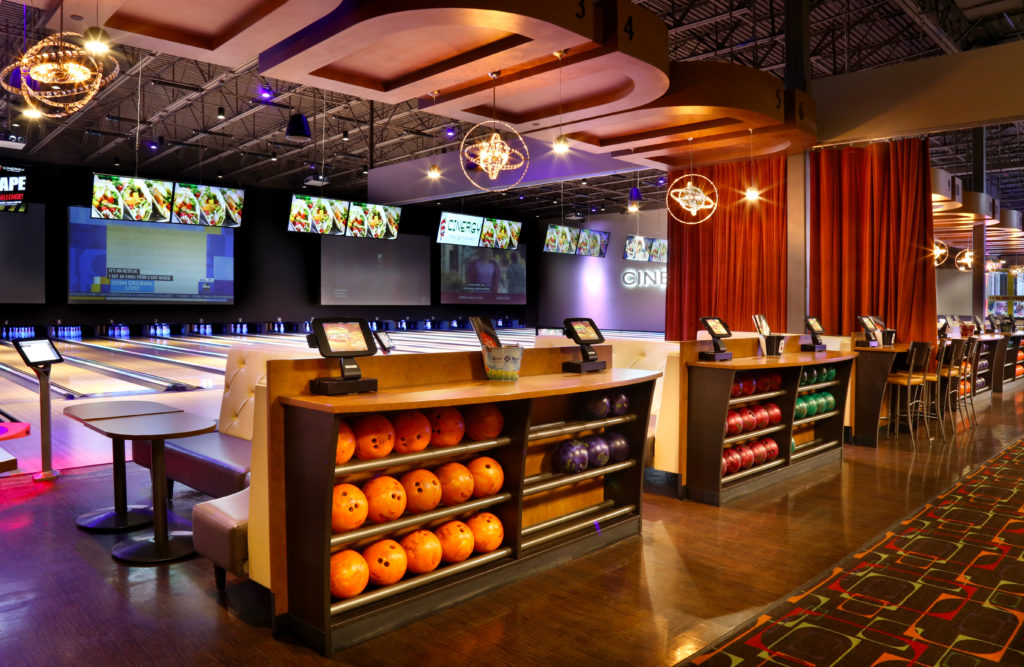
A similar movement was simultaneously taking place at the other end of the world. South Korea’s CJ CGV opened its first multiplex in 1998, helping drive a new era of moviegoing in its home market. By 2010, the emergence of new technologies and increased prominence of home-entertainment platforms pushed the circuit’s executives to reconsider their growth strategy for the future.
According to CJ CGV CEO Jung Seo, the company saw the strength of its circuit not in the films it programmed, but in the out-of-home entertainment experience it provided. In a keynote address delivered at CinemaCon 2018, Seo explained why the circuit started to shift its focus away from principally marketing studio titles and more into branding CJ CGV as an entertainment venue. “If that’s how we define ourselves,” as a place for people to go watch a movie, “then we will constantly be under the threat of being replaced by other channels for watching movies or other forms of entertainment,” he said. “Rather, the value of CGV is to provide our customers the most attractive place in which to have a communal social experience.”
The result was the creation of a new concept for its cinemas. “Several years ago we decided to redefine ourselves from being a multiplex to being a ‘cultureplex,’” said Seo. “For us, being a ‘cultureplex’ means to be a cultural playground, where people can gather to experience all different types of culture, from film, music, performances, games, food, drinks, and so on.”
CJ CGV opened its first cultureplex location in South Korea, CGV Chungdam, in 2011. The concept has grown alongside the circuit’s global expansion; today there are more than 580 cultureplex locations in eight countries around the world. The company’s cinema technology arm, CJ 4DPlex, offers experiential innovations that can be integrated into cinemas, such as immersive seating (4DX), panoramic screens (ScreenX), and virtual reality (4DX VR), to other major circuits around the world.
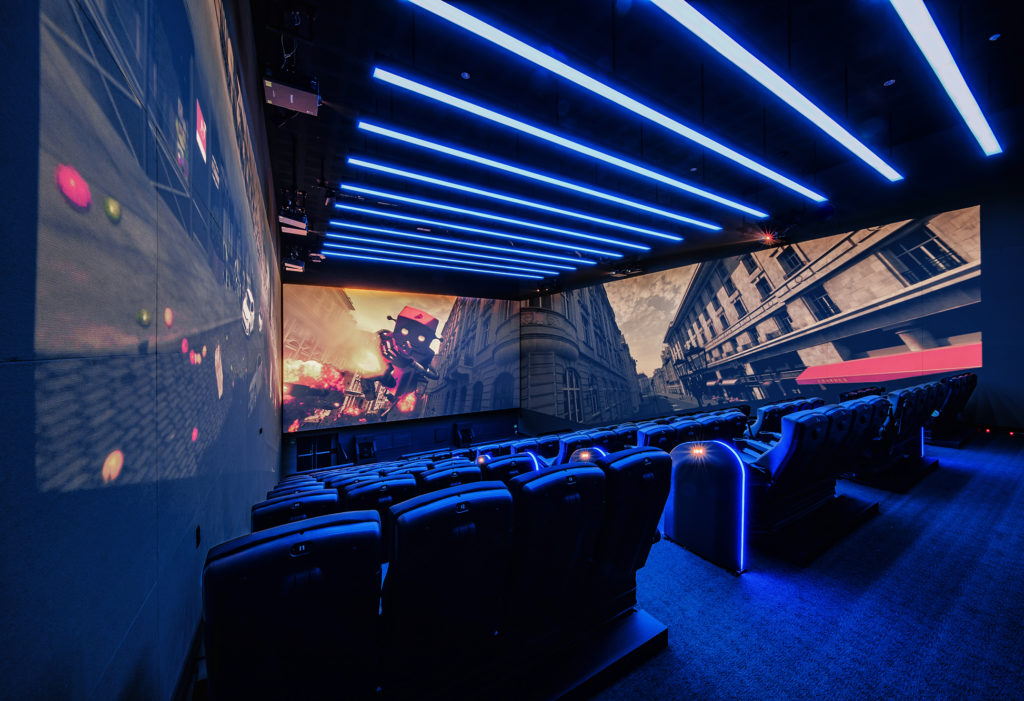
Back in the United States, third-generation exhibition veteran Kevin Mitchell was similarly looking at ways to expand the scope of what cinemas could offer to their patrons. “We first started toying with the idea of adding an entertainment component that would help us get away from being a completely product-driven business when I started [ShowBiz Cinemas] in 2007,” says Mitchell, who serves as the circuit’s CEO. Mitchell was interested in adding another profit center to his new circuit but was wary of “just slapping a bowling alley onto a movie theater.”
“We spent a lot of time at the drawing board pioneering a manageable and consistently profitable entertainment destination that incorporated bowling, arcade gaming, movie auditoriums, a full bar, and our food and beverage concept into a unique and cohesive experience for our customers,” he says. The process was delayed as the real estate market slowly recovered from the 2008 recession; it took time to convince banks and development partners to invest in innovation in what was already a mature industry.” Showbiz’s first Bowling, Movies and More! was unveiled in Baytown, Texas, in 2015. The circuit expects to have at least six cinema entertainment centers in its fleet by the end of 2020, with plans to open multiple additional locations in the coming years.
As with cinema dining in the previous decade, Texas became a hotbed of innovation when it came to cinema entertainment centers throughout the 2010s. Santikos Entertainment, which operates nine theaters in the San Antonio area, leveraged its own in-house real estate team to find and develop the ideal location for its first CEC. That site, Santikos Casa Blanca, opened in June 2016 and incorporates 16 lanes of bowling, an arcade, sports bar, and café. Santikos recently announced plans to open another CEC in what will be its 11th San Antonio location.
Evo Entertainment, the brainchild of Mitchell Roberts, another Texas executive with deep multigenerational roots in the industry, opened its first CEC in November 2014. Located in Kyle, Texas, the 70,000-square-foot complex houses 11 screens, 14 bowling lanes, a 3,500-square-foot game arcade, a bar and grill, and spaces for parties and corporate events. Today, Evo has six Texas locations, with a seventh, in southwest San Antonio (its largest at 80,000 square feet), scheduled to open in January 2021.
Its CEC in Schertz, Texas, which opened in March 2019, boasts an outdoor patio with fire pits and oversized TV screens. “The goal has always been to turn our facilities into social destinations where, whether it’s going to a movie or going to the family-entertainment-center side, people are just escaping their daily lives to hang out and be social. And what better place to do that in central Texas than outside on a patio?” Roberts says.
“The beautiful thing about Texas is that it is such an innovative state when it comes to our industry,” he says. “Texas [can be seen] as the birthplace of dine-in cinema, one of the birthplaces of the hybrid model. We have a lot of great operators—and a lot of saturation in markets with innovative concepts. I don’t want to say it would be easier to operate outside of Texas, because I don’t think that’s the case, but it would be very beneficial to get outside and see what the hybrid model can do in markets that haven’t seen it yet.”
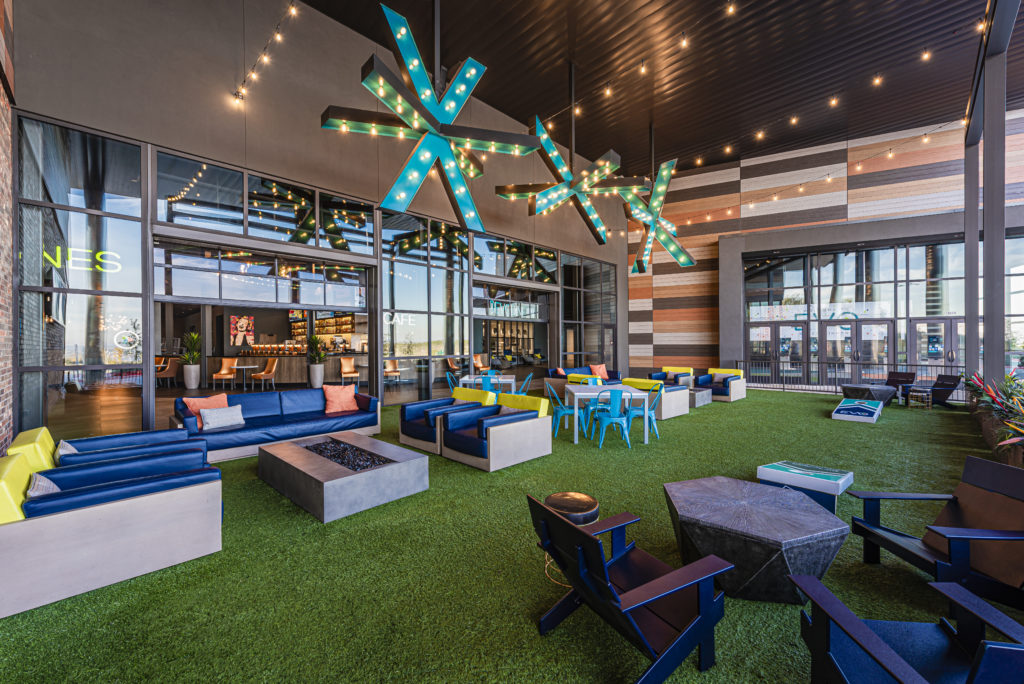
Despite justifiable Texas pride, the CEC concept has been introduced in new parts of the United States in recent years. B&B Theatres had its first internal discussions about adding a CEC to its circuit as early as 2013. “There would be conversations where our CFO said, ‘Look, theaters are our core competency. Why would we want to go into a business that we do not have a core competency in?’ I didn’t have the data. At that point my argument was, we just should!” says Dennis McIntire, B&B’s executive director of development and construction. “I will tell you right now, I was right and he was wrong—and I’d really like for that to get into the article. If you only quote me once in this story, ‘I was right; he was wrong.’ It took a lot of conversations to bring everybody on board.” [Editor’s Note: As someone who is frequently on the losing end of similar conversations with a CFO, I have obliged Mr. McIntire’s request.]
B&B was right to be cautious. Opening a cinema entertainment center requires additional investments in time, space, money, training, and maintenance—on top of the already straining demands of operating a cinema. “You need training programs, manuals, books, procedures, and processes for everything in the building,” says Cinergy’s Benson. “There are different little sub-businesses within the business. That means having individual standard operating procedures for running the ropes course, the ax throwing, the game room, and redemption store, for running a bar—and, of course, for having a restaurant. We had to learn all these different little sub-industries, besides the food and beverage component. It took time and a whole lot of money.”
B&B’s McIntire sat down with the different vendors that would be involved in running a CEC to get a better understanding of the numbers behind the business. Ultimately, with the right numbers and the support of the executive team and developer, the circuit decided to commit to opening its first CEC in its new Ankeny, Iowa location in 2018. The success of that site was proof of concept for B&B Theatres; the circuit has already announced plans to add CEC locations to new builds in Kansas City, Missouri, and Red Oak, Texas, in the coming months.
Committing to the CEC concept requires a great deal of space and a certain amount of flexibility. While a regular cinema can be housed in a building of around 40,000 square feet, CECs often require twice as much space to be viable entertainment destinations. Finding a building big enough to accommodate entertainment attractions isn’t enough; its location is also crucial to the concept’s success. “You can’t just build this in the middle of a field. You want the development to come in around you,” says McIntire. “If you’re working with a developer who’s just looking to fill 80,000 square feet in a second-tier strip center, that probably won’t work. This is a very expensive building, and if you don’t have the people in the market to support it, then it doesn’t matter if you build a cathedral. If there are no parishioners, there’s nobody coming to church.”
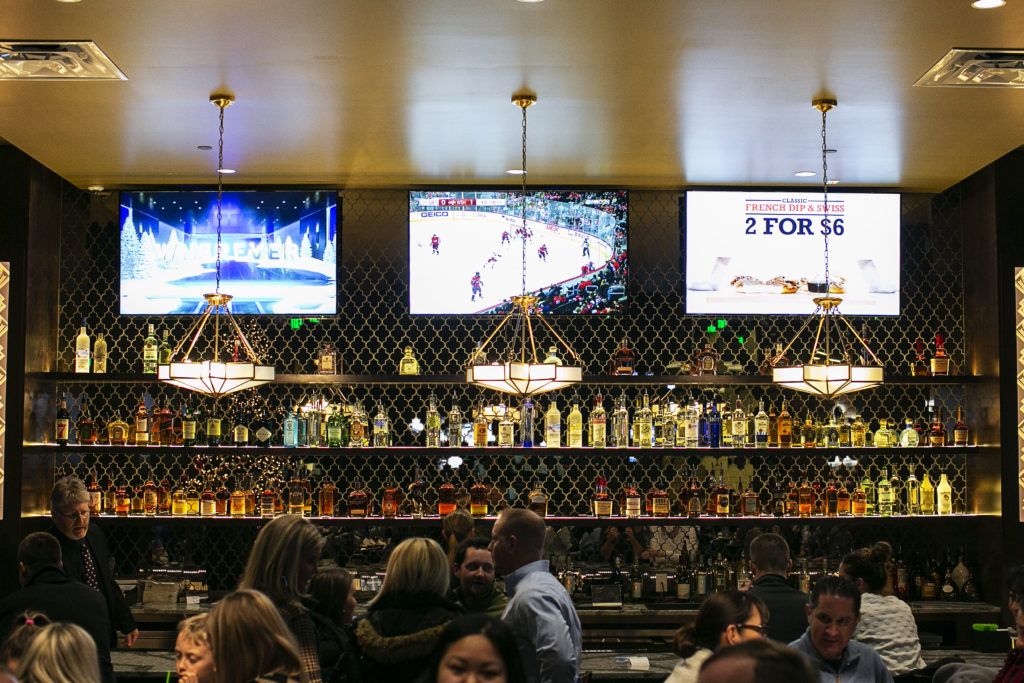
“We’re looking for high-income, but not too high-income,” says B&B Theatres executive vice president Brock Bagby about his circuit’s ideal demographic for CECs. “We’re targeting young families in fast-growing markets with continuous growth. We’re excited about those markets that are on the edge of a major city and are exploding. You see that a lot all over the nation, towns that are an hour from downtown, but they’re exploding and building thousands and thousands of new homes. That’s all driven by young families with disposable income—not necessarily the ‘1 percent,’ who don’t go out to the movies as much. Kind of upper middle class; that’s your target demographic.
“It’s similar to Topgolf’s approach. There’s only so many in any given market,” Bagby adds, referring to the trendy entertainment venues that combine a modified golf driving range with an adult-orientated lounge. “We’re looking at a second site in Des Moines, but we don’t feel like there’s room for a third or fourth site. Topgolf did the same thing in Miami. They only have two locations there. You can definitely overdo it. You need to know each market. Because you’re not just building another movie theater; you’re building something that you want people to drive to from an hour away.”
Once a location is secured, its layout plays an outsize role in its eventual earnings, says Cinergy’s Benson. “People–flow within the building is critical. In a movie theater, you come in, you hit the concession stand or stop by the bathroom on the way to the auditorium, you leave. With cinema entertainment centers, you need to set them up where people can get to the game room, find the bowling, and stop by the bar on their way in or out of the auditorium. I’ve got some that are laid out wrong and others that are laid out right, and the percentages of revenue between the two are radically different from each other.”
“We learned a lot from our Casa Blanca location. There are things we would have done differently there,” says Andrew Brooks, executive director of marketing and sales at Santikos. The circuit applied the lessons from its first location in planning for its second CEC, Santikos Cibolo, which opened in May 2019. “We moved some things around, switched some games to different spots, and it’s been fantastic. We have a virtual reality area that we can expand as it grows—or move out if we need to. We have a 4,000-square-foot, two-level laser tag that’s been amazingly successful as we gain traction in team building and corporate events. We designed those spaces, keeping in mind that if they weren’t succeeding or working out, we could change them into an auditorium or something else.”
Once a building is laid out, operators customize their own CEC by selecting attractions to supplement the movie theater portion of the building. It takes diligence to ensure each part of the building is performing to expectations. Cinergy has kept a close eye on what to incorporate in its CECs in its 11 years in the sector, always careful to be flexible and innovative so nothing inside the building goes stale. “Back when we started it was all about bowling, which is still popular, and laser tag, which we’re moving on from,” says Benson. “Today you have ax throwing, giant arcade games, and escape rooms—attractions that weren’t around even five years ago.”
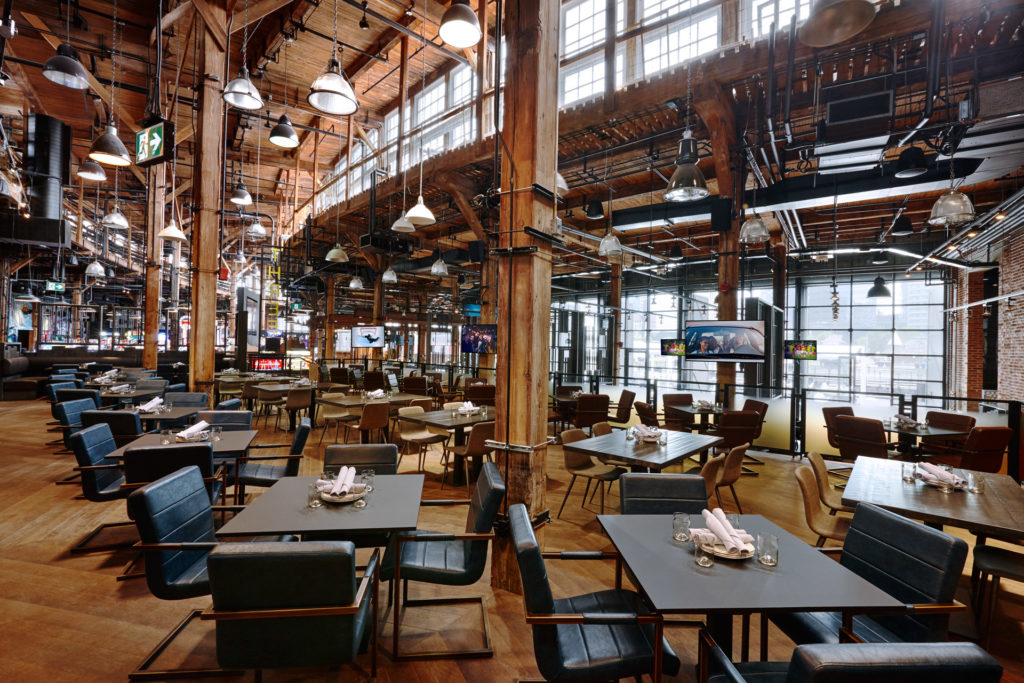
Benson brings up escape rooms as an example of a fad that can suddenly emerge, only to become saturated and go out of fashion just as quickly as it came. “Five or six years ago escape rooms barely existed in this country. At this point, I wonder if escape rooms haven’t already run their course—we are thinking about not including them going forward,” he says. “At some point it gets saturated. Movie theaters are hard to replicate—they’re big and expensive—but an escape room or ax-throwing business, they come and go. They can open up in a retail shop with three or four thousand square feet on a three-year lease, make their money while it’s popular, and leave when it starts to wane. That’s why we need to continually reprogram our locations with the latest and greatest concepts; you never know when three escape-room places could open around the corner from you. Before you know it, everybody’s escape roomed out [and] your revenue goes down. That’s a lot of square footage dedicated to something that doesn’t make much money anymore. We need to keep up with all the amusement options out there to figure out which ones are the best and how long they might last.”
Kevin Mitchell from ShowBiz Cinemas recognized that challenge in developing his circuit’s CEC concept, which is why he decided to focus on getting the basics of the building right. “While there are countless trendy attractions that can be incorporated into an entertainment center, we’ve drilled down our focus to boutique bowling, movies, arcade games, prize redemption, and food and beverage concepts,” he says. “We’ve found this allows us to be really good in those areas without being solely dependent on a studio release schedule, and it also allows us to be a dominating destination zone for entertainment while maintaining a manageable footprint that is a good fit for a variety of markets.”
Although arcades have been a regular feature of cinema lobbies for decades, operating a full-scale game zone with a redemption center presents a host of new challenges to operators coming from a traditional theater background. “In an arcade, you can have 40 games, and 22 of them will have some type of mechanism or play-action where the customer is throwing, rolling, kicking—doing something to the machine. It’s going to break down,” says B&B’s McIntire. “The balls are going to end up in the wrong spot. The same applies to bowling: you’ve got a 15-pound ball rolling 25 miles an hour at 10 projectiles. Something’s going to break. That was our biggest mindset that we had to get over, that this was going to require a lot more attention per square foot than any of our theaters,” he says.
Sarah Van Lange, Cineplex’s executive director of communications, says one of the biggest challenges of operating an arcade at a CEC is “finding the right combination of games that will continue to excite our guests every time they visit our theaters. Fortunately, we have a team of experts who not only keep up on trends in amusement gaming but understand which games will appeal to which demographics, creating that perfect mix of the latest high-tech and classic, nostalgia-filled games,” she says.
Based on the success of its Xscape concept, Cineplex has incorporated new, branded locations into its circuit. These include Playdium, targeted to younger crowds, where approximately two-thirds of the complex is dedicated to the latest amusement games, bowling, and virtual reality, with the other third offering a range of on-the-go bites and handcrafted dishes. Cineplex plans to open 10 to 15 Playdium locations in midsize communities throughout Canada this year. The company also has eight locations of The Rec Room, family entertainment centers (FEC) without cinemas that offer food, live entertainment, amusement gaming, and feature attractions under one roof.
This past November, Cineplex announced yet another concept, its most wide-ranging yet: Junxion. Anne Fitzgerald, the circuit’s chief legal officer, describes the concept as “a cross between the Rec Room experience and the theater experience, having both in the same building.”
“Junxion guests will have their pick of exciting programming and events, including live music, trivia nights, game nights, outdoor screenings of movies and live TV events, and more,” adds Van Lange. The complex will also feature an arcade with new and classic video and redemption games, virtual reality experiences, and a food hall including an indoor food truck and a bar selling wine and craft beer. Cinemas will remain an integral part of the Junxion concept, including Cineplex’s UltraAVX premium screens and food and drink service as viewers relax in their recliner seats.”
Cineplex plans to roll out the Junxion concept in Canada in the coming years. “We will leverage retrofits of our existing theater network as well as new locations, including at Kildonan Place in Winnipeg, Manitoba, and the first Junxion location at Erin Mills Town Centre in Mississauga, Ontario,” says Van Lange.
By adding a cinema component to its already popular Rec Room concept, Cineplex’s Junxion idea acknowledges the drawing power movie theaters retain in attracting patrons to a CEC. Evo’s Roberts confirms that the biggest draw at his circuit continues to be new releases. “People are still coming in to see movies,” he says, “but as we’ve continued to improve and learn the FEC side, we see a significant amount of traffic that comes from that, too. They really feed each other.”
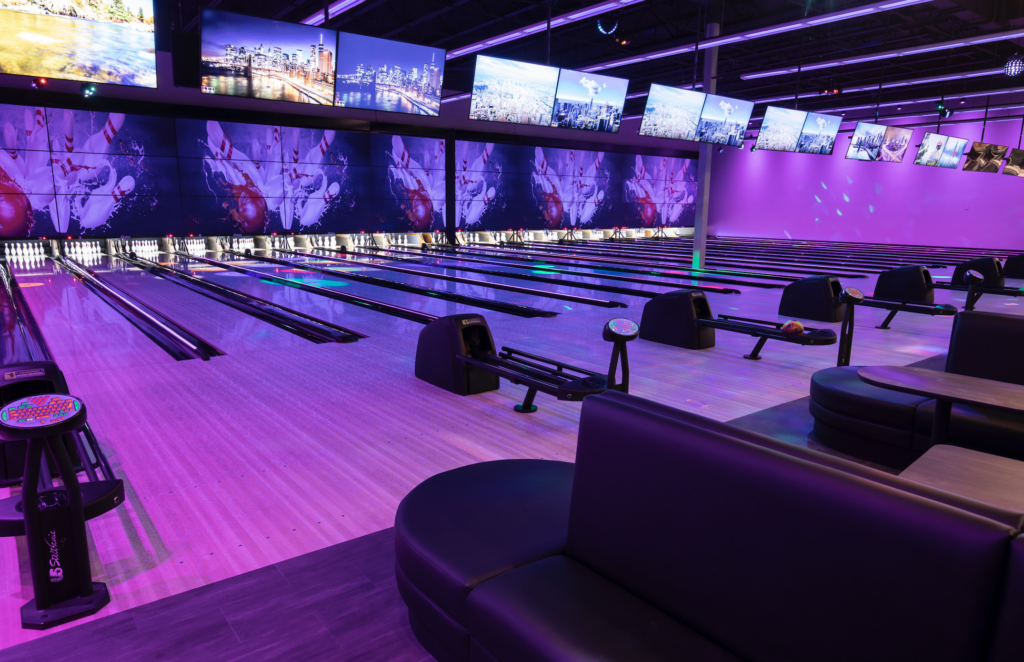
The success of film programming has inspired some traditional FEC operators to add cinemas to their buildings, approaching the CEC concept from the other end of the spectrum. FatCats Entertainment opened its first FEC in Salt Lake City in August 2001, offering bowling, miniature glow golf, an arcade, and a bar and grill. Similar locations followed in Provo, Utah (2002); Ogden, Utah (2007); and Westminster, Colorado (2010).
Business predictably boomed or slowed depending on the weather. “We had a pretty profitable business six or seven months of the year, but during the summer months, we were giving back most of the profits that we made during the periods of time when the weather wasn’t great,” says co-founder David Rutter.
That’s when FatCats decided to try its hand at exhibition. In 2010, the company opened its first cinema in its complex in Rexburg, Idaho, a renovation of an existing site. “There was definitely a learning curve when it came to the intricacies of booking films, determining the right size and how many auditoriums, how many seats to make it work in the most efficient way,” says Rutter.
That seasonal trend was reversed at the company’s Gilbert, Arizona location—its second location to incorporate a cinema—where the summer heat drives people to air-conditioned indoor spaces. “We had a lot of people coming who had no idea about [the theater],” says Rutter. “It took time to build that business up. Thank heavens for Star Wars that winter, in December of 2015. Most of the other theaters were full and people realized, ‘I can’t get into my normal theater, but I guess there’s a theater over here, so we’ll go check this place out.’ That’s when the business began to grow.”
Since then, FatCats has added cinemas to its new locations in Saratoga Springs, Utah, and Mesa, Arizona—and has plans to make its upcoming location in Queen Creek, Arizona, a CEC as well.
“The movies really drive [business]. That’s the beauty of it; Hollywood spends millions of dollars promoting films, and we’re a place where people can come to experience that,” says Rutter. He has observed that once they’re in the building, patrons are more willing to spend additional money on the other entertainment attractions on hand. Evo’s Mitchell Roberts has the data to back up that assertion: “We see an average of about three and a half hours per visit compared to the traditional cinemas, where we’re seeing anywhere between an hour and a half to two hours. People stick around longer.”
A lot more space translates into the need for a lot more employees. Yet just because CEC locations are (at least) twice as big as regular movie theaters, it doesn’t mean that simply doubling the staff will suffice. Mark Moore, CEO of Entertainment Properties Group, which runs both traditional FEC brands and a new CEC project under the Strike + Reel banner in Texas, is unequivocal about the hardest part of the business. “The biggest challenge is staffing a 90,000-square-foot venue,” he says. “A facility this large has to have an extensive management team in place.”
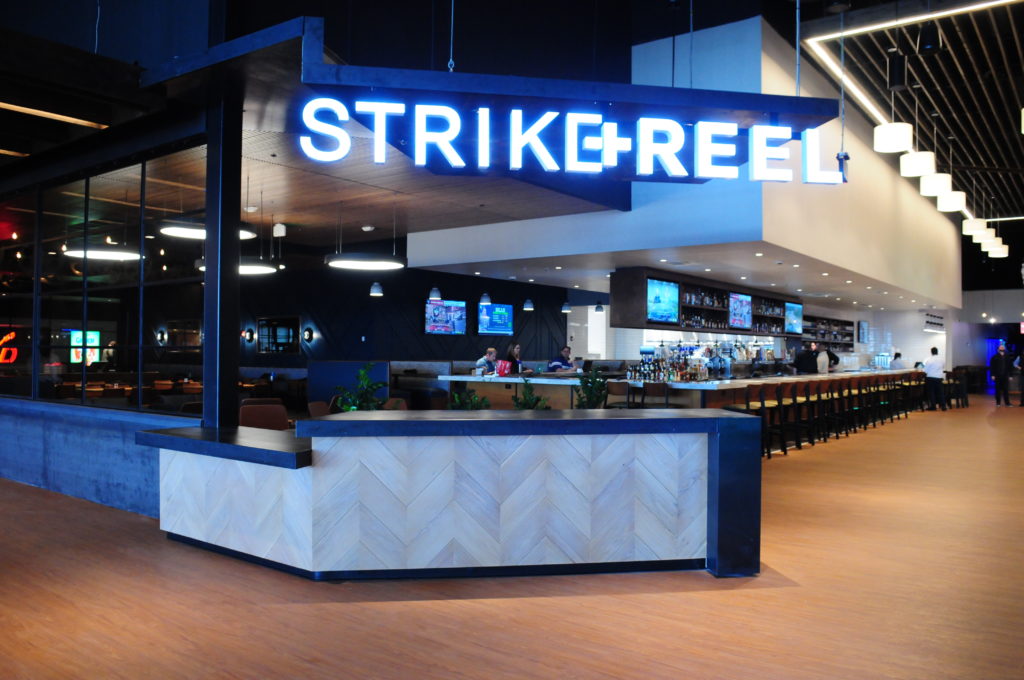
B&B’s Brock Bagby cites staffing as the most unexpected element in his own circuit’s incursion into the sector. “We’ve been very surprised at how challenging it is,” he says. “The amount of payroll … you have to staff bowling, the arcade, the restaurant. [At a regular theater] it’s just tickets and concessions. Now we’ve got two full kitchens: one for the theaters, one for the restaurant. The staffing is more than double a traditional theater. And the operations to run these things are just huge. You’re running three or four businesses in one. It’s a lot more work than we ever anticipated, but it’s exciting. … We have 10 managers in our Ankeny location. Ten!”
B&B Theaters went as far as creating a dedicated team whose sole job is opening its CEC locations. The circuit has plans to add five more CECs (which it calls “Luxury Entertainment Centers”) to its fleet of cinemas in the coming years. “We’re taking it a step further with a ropes course, karaoke rooms, escape rooms, and then we have an outdoor component that we’re working on,” says Brock Bagby.
Cinergy, a circuit that exclusively hosts CECs, counts on a corporate office of 35 executives to oversee operations for its five existing locations. “That’s a big corporate overhead for just five theaters, but we’re set up to go out and add probably 10 more over the next few years without having to add too many more people,” says Jeff Benson.
Since the trend is still in its relatively early stages, the potential for nationwide expansion is vast. Like the dine-in, recliner, PLF, and VIP auditorium trends that have come before, the CEC may be seen as a gimmick today but could quickly proliferate across the market if the business model remains strong. Rutter, from FatCats Entertainment, emphasizes the profitability of attractions that don’t carry sustained costs. “Our profit margin isn’t as high on food as it is on, say, bowling or miniature golf—those kinds of things where you don’t have an inherent cost of goods that you’ve got to pay,” he says.
Other factors, such as the rise of the experience economy—where out-of-home experiences are considered more valuable than home-entertainment platforms—or the increased availability of retail space as consumers shift their buying habits online, could become catalysts in the rise of cinema entertainment centers in the domestic market.
For an exhibitor like Cinergy, the CEC concept represents an ideal growth strategy in today’s era of industry consolidation among studios and exhibitors—but only if you use the right tactics. “You want to maximize gross margin,” says Benson. “Let’s face it, we don’t make a lot of money on the movies—we need to split that with the studios. If someone is going to spend $10 at my place, where do I want them to spend it? We focus on the areas we know can make the most money, and that to me is where a lot of mistakes are being made when people say they’re seeing marginal results from this business. It’s not that the entertainment concepts are wrong. It’s likely that the building’s layout has a lot to do with its performance.”
For Cinergy, CECs have been successful because the concept is consistently updated and refined; passing fads are avoided. That sort of big-picture approach stands in stark contrast to the day-to-day operations of a traditional movie theater, where a cyclical release calendar requires less hands-on attention by management. “That’s the thing about movies: They reprogram themselves every week. It’s always fresh,” says Benson. “You reinvest in regular theaters with new technologies like digital projectors and recliners, but the content changes every week. That’s not the case in an entertainment center. You need to continually reinvest and update the other half of your building, the half without a movie theater, to make sure your revenue isn’t declining each year.”
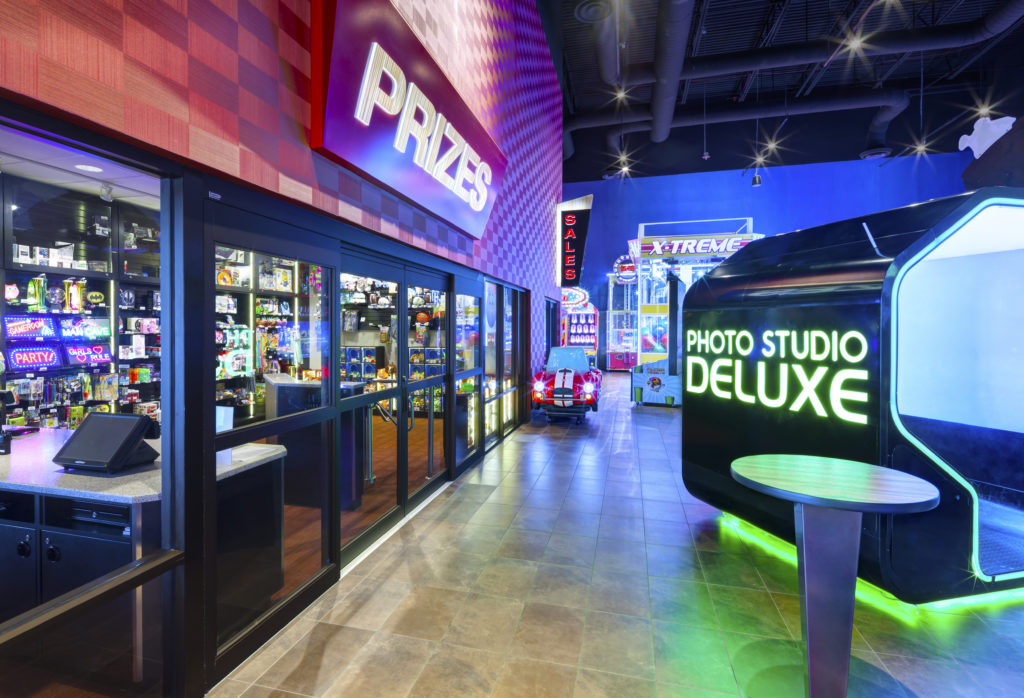
If tackled correctly, cinema entertainment centers can help distinguish a circuit’s identity and help define its brand as a unique out-of-home-entertainment destination. For a circuit like ShowBiz Cinemas, which operates both traditional theaters and CECs, it represents a great opportunity in the coming decade. “We’ve had great success with our Bowling, Movies and More! concept since opening our first location. We are finding new ways to improve it with each new facility we build,” says Mitchell. “These buildings are expensive to build and very labor intensive, and we continue to look for ways to improve in those areas without sacrificing quality.”
Around 56 percent of the ShowBiz circuit incorporates entertainment components that its traditional theaters don’t offer. ShowBiz is introducing its CEC concept to the renovation of its Waxahachie, Texas location—and will bring Bowling, Movies and More! to a new site in Idaho Falls, Idaho, scheduled to open in December. By the end of 2020, it expects cinema entertainment centers to comprise 70 percent of its total footprint.
“As we continue to grow, our Bowling, Movies and More! entertainment-center concept is driving the entire ShowBiz brand,” he adds. “We’ve been very pleased with the success of this concept, and all of our new builds going forward will be with our signature entertainment-center concept. We’re in rapid growth mode right now and will be opening multiple [CEC] locations across the country annually.”
For a circuit like Cinergy, refining and perfecting the CEC concept is a long-term commitment—not only to its customers, but to staying a step ahead of its competitors. In December, the circuit announced its Amarillo, Texas location (opened in 2018) had been honored as the world’s top family entertainment center at the annual convention of the International Association of Amusement Parks and Attractions (IAAPA). More than 120 judges participated in selecting the winner from among IAAPA’s 5,300 members, representing over 100 countries.
As the trend continues to grow beyond Texas, Benson is more determined than ever to continue thriving in the business. “It’s still early. You’re seeing larger circuits like B&B Theatres building some of these centers, but most big circuits haven’t delved into it deeply yet,” he says. “What you see now is similar to what was going on in the early days of dine-in, where you have the smaller independents that are more flexible with their business models taking the risk and adopting these concepts. I think you’re going to see a whole lot more of them. I wish I could say we’re the only ones doing this. We know we aren’t, and that’s OK. We want to pick our locations strategically and build as many as we can, as fast as we can.”
The post The Next Big Thing: The Rise of Cinema Entertainment Centers appeared first on Boxoffice.
from Boxoffice





0 comments:
Post a Comment